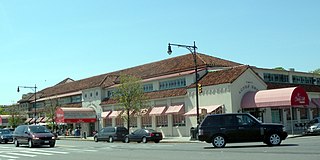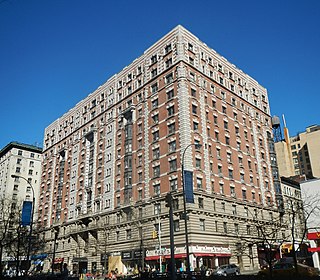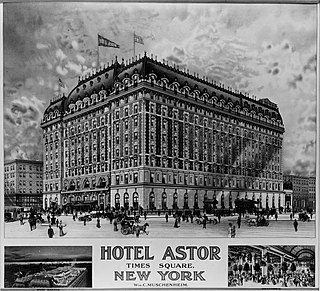Related Research Articles

52nd Street is a 1.9-mile (3.1 km)-long one-way street traveling west to east across Midtown Manhattan, New York City. A short section of it was known as the city's center of jazz performance from the 1930s to the 1950s.

The St. Regis New York is a historic luxury hotel at 2 East 55th Street, at the southeast corner with Fifth Avenue, in the Midtown Manhattan neighborhood of New York City. The hotel was originally developed by John Jacob Astor IV and was completed in 1904 to designs by Trowbridge & Livingston. An annex to the east was designed by Sloan & Robertson and completed in 1927. The hotel is operated by Marriott International and holds Forbes five-star and AAA five-diamond ratings. In addition, it is a New York City designated landmark.

Lundy's Restaurant, also known as Lundy Brothers Restaurant, was an American seafood restaurant in the Sheepshead Bay neighborhood of Brooklyn, New York City, along the bay of the same name. Lundy's was founded in 1926 by Irving Lundy as a restaurant on the waterfront of Sheepshead Bay; five years later, the original building was condemned to make way for a redevelopment of the bay. The present building opened in 1934 or 1935, and closed in 1979. Another restaurant operated in the Lundy's building from 1997 to early 2007, after which the building was converted into a shopping center.

The Hotel Carter was a hotel located near Times Square in Manhattan, New York City. The building is 24 stories tall, and at its opening, had 1,000 rooms, but was later downsized to 700 rooms. Opened in 1930 as the Dixie Hotel, it originally extended from 43rd Street to 42nd Street, although the wing abutting 42nd Street has since been demolished. The hotel has changed ownership numerous times throughout its history. In October 1976, it was renamed the Hotel Carter in an attempt to rehabilitate its image. The hotel closed and was offered for sale in 2014.
The Weylin Hotel was a hotel at 527 - 531 Madison Avenue and 40 - 54 East 54th Street in New York City. It was on the southeast corner of 54th Street. The structure was sixteen stories tall and opened in March 1921. The building fronted sixty-one feet on Madison Avenue and one hundred forty-eight feet on 54th Street. It contained 125,000 square feet (11,600 m2) of space.

The Allerton Hotel for Women, today known as Renaissance New York Hotel 57, is a hotel located at 130 East 57th Street in the New York City borough of Manhattan. It is a seventeen-story brick, limestone, and terra cotta building designed by Arthur Loomis Harmon in 1920. It was built on the southwest corner of Lexington Avenue and 57th Street by the Allerton House Company at a cost of $700,000. It originally had stores on its ground floor. The hotel intended to accommodate six hundred business and professional women and also shelter young girls. When completed in 1923, the Allerton Hotel had room for four hundred tenants. Its occupancy was filled prior to completion and there was a long waiting list. After opening it was so popular that another establishment of its kind was anticipated.
The Studebaker Building is a former structure at 1600 Broadway on the northeast corner at 48th Street in Manhattan, New York City. It was erected by the Juilliard Estate, in 1902, between Broadway and 7th Avenue, in the area north of Times Square. It was demolished in 2004 to make room for an apartment tower, a twenty- five story, 136 unit, luxury condominium designed by architect Einhorn Yaffee Prescott.

Bretton Hall is a twelve-story residential building at 2350 Broadway, spanning from West 85th to 86th Street on the Upper West Side of Manhattan, New York City.
The Paris Decorators Corporation was founded in 1911 and operated a chain of nine furnishing stores in the metropolitan New York City area. The business specialized in curtains, interior decoration products, draperies, and furniture. It was based in Newark, New Jersey but maintained its general office and factory at 28 West 23rd Street. Among its principal competitors in the 1930s retail business was Mrs. Dodd, Inc., located in Manhattan.
The Silk Centre was an area of business property, composed of buildings and lofts, which opened in Manhattan, in 1924. It was adjacent to a car-barn site, numerous clothing firms, and advertising agents located within a block or two of this corner. Harper & Brothers was also situated on East 33rd Street.
The Gunther Building was a seven-story commercial edifice in Manhattan located at 391 - 393 Fifth Avenue, between 36th Street and 37th Street. It occupied a plot 41.8 feet (12.7 m) on Fifth Avenue by 111.8 feet (34.1 m) in depth. Built in 1909, the establishment conformed in architecture, appointments, and construction with the Tiffany and Company Building, which adjoined it. The latter structure was designed by Stanford White and was constructed by Tiffany & Company in 1903, at the corner of the block on 37th Street.

3 East 57th Street, originally the L. P. Hollander Company Building, is a nine-story commercial building in the Midtown Manhattan neighborhood of New York City. It is along the northern side of 57th Street, just east of Fifth Avenue. 3 East 57th Street, constructed from 1929 to 1930, was designed by Shreve, Lamb & Harmon in an early Art Deco style.

The Taft Hotel building is a 22-story pre-war Spanish Renaissance structure that occupies the eastern side of Seventh Avenue between 50th and 51st Streets, just north of Times Square, in the Midtown Manhattan neighborhood of New York City. In its modern configuration, it features two separate portions with their own entrance on 51st Street. The larger portion is devoted to the residential condominium called Executive Plaza, with each of its 440 units being privately owned. Certain units are rented by their owners to the public. A smaller portion of the building contains The Michelangelo, a Starhotels hotel.
Cipriani S.A. is an Italian hotel and leisure company domiciled in Luxembourg that owns and operates luxury restaurants and clubs around the world including Harry's Bar in Venice and formerly the Rainbow Room in New York City. It specialises in simple, traditional Italian food.

Childs Restaurants was one of the first national dining chains in the United States and Canada, having peaked in the 1920s and 1930s with about 125 locations in dozens of markets, serving over 50,000,000 meals a year, with over $37 million in assets at the time. Childs was a pioneer in a number of areas, including design, service, sanitation, and labor relations. It was a contemporary of food service companies such as Horn & Hardart, and a predecessor of companies such as McDonald's.

The Eitel Brothers refers to a family of four brothers, Emil, Karl, Robert and Max Eitel, originating from Stuttgart in Germany who, from 1894, were hoteliers and restaurateurs in Chicago, USA. They were well known for the luxury hotel Bismarck Hotel and restaurants such as the Marigold Gardens and the Old Heidelberg Inn. Typically excluded is Albert Eitel, who remained in Stuttgart as an architect.

The construction of the Rockefeller Center complex in New York City was conceived as an urban renewal project in the late 1920s, spearheaded by John D. Rockefeller Jr. to help revitalize Midtown Manhattan. Rockefeller Center is on one of Columbia University's former campuses and is bounded by Fifth Avenue to the east, Sixth Avenue to the west, 48th Street to the south, and 51st Street to the north. The center occupies 22 acres (8.9 ha) in total, with some 17 million square feet of office space.

608 Fifth Avenue, also known as the Goelet Building or Swiss Center Building, is an office building at Fifth Avenue and West 49th Street in the Midtown Manhattan neighborhood of New York City, adjacent to Rockefeller Center. It was designed by Victor L. S. Hafner for the Goelet family, with Edward Hall Faile as structural engineer. The facade uses elements of both the Art Deco style and the International Style, while the lobby was exclusively designed in the Art Deco style.

2 Park Avenue is a 28-story office building in the Murray Hill neighborhood of Manhattan in New York City. The structure, along the west side of Park Avenue between 32nd and 33rd Streets, was designed by Ely Jacques Kahn and was developed by Abe N. Adelson from 1926 to 1928. The building is owned by Morgan Stanley Real Estate and is a New York City designated landmark.
Manger Hotels was a major 20th-century national chain of luxury hotels, full service motor inns, and upscale motels. Originally founded in 1907 as a chain of luxury hotels by Julius and William Manger, the company shifted to extensive development of large strategically located motor inns and motels in the 1960s.
References
- ↑ New Incorporations, New York Times, September 5, 1931, pg. 25.
- 1 2 Business Leases, New York Times, November 15, 1933, pg. 40.
- ↑ Max Rosoff Dies; Restaurateur, 82, New York Times, May 7, 1962, pg. 31.
- ↑ $468,000 World's Fair Bonds Bought By Macy's, New York Times, January 11, 1937, pg. 22.
- ↑ Latest Recorded Leases, New York Times, July 20, 1934, pg. 31.